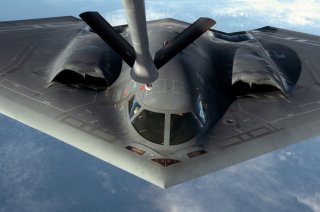America Shouldn’t Panic Over China’s New H-20 Bomber
A British report calls the H-20 “truly intercontinental.”
Here's What You Need to Remember: While the effectiveness of an H-20’s stealth characteristics may not be known, the U.S. history and experience with stealth could be one reason why U.S. Air Force senior weapons developers regularly say the B-21 does incorporate leap-ahead stealth technologies and can “hold any target at risk, anywhere in the world, anytime.”
Just how big of a deal is China’s new H-20 stealth bomber, an emerging platform reported to operate at ranges longer than a U.S. B-2, massively expands China’s attack reach and places Guam, Hawaii and even the continental U.S. at great risk on a single mission?
A study performed by the London-based Royal United Services Institute for Defence and Security cited the anticipated range of the bomber as well as its potentially quite concerning long-range weapons.
“Armed with nuclear and conventional stand-off missiles, the H-20 would represent a major break from previous PLAAF (PLA Air Force) doctrine and equipment development practice,” the report stated, as cited in the South China Morning Post.
The British report calls the H-20 “truly intercontinental.”
Developers and news reports claim that the stealth aircraft will be able to hit ranges as far as 7,500 miles, carry nuclear weapons and introduce 5th-Generation levels of stealth technology, targeting and computing.
Is this true? That may not be known but any assessment of the H-20 subsonic bomber, it seems, should be viewed in the context of the U.S. B-21.
The H-20 looks like a B-2, but it may not rival the B-2, let alone challenge the B-21. While China is known for its rapid development of AI, advanced computing and emerging weapons systems such as hypersonics, it does not have a history of engineering stealth platforms that is in any way analogous to the U.S.
While an external radar signature-reducing shape might be easy to attempt to copy, as may be the case given how similar the H-20 looks to a U.S. B-2, truly advanced stealth incorporates a wide sphere of technologies to include composite, radar-absorbent materials, heat signature reduction systems such as IR suppressors and exhaust systems and, perhaps most of all, internally buried carefully architected engine technology engineered to operate at much lower temperatures than most aircraft.
One of the key technical goals of stealth is, among other things, to build an aircraft that can, while in flight, approximate the surrounding atmospheric temperature as closely as possible to remove any detectable margin of difference. While many specifics of stealth technology are obviously not available for security reasons, they regularly involve specific methods of managing exhaust fumes or high-temperature air from trailing an aircraft.
One need not look very far to see the long history of U.S. technical development when it comes to stealth, as the Gulf War’s F-117 Night Hawk stealth fighter introduced stealth platforms to the world. That was 30-years ago, a circumstance which clearly reveals that the U.S. has been developing, refining, and improving an entire sphere of stealth technologies for decades now.
So, while the effectiveness of an H-20’s stealth characteristics may not be known, the U.S. history and experience with stealth could be one reason why U.S. Air Force senior weapons developers regularly say the B-21 does incorporate leap-ahead stealth technologies and can “hold any target at risk, anywhere in the world, anytime.”
Kris Osborn is the defense editor for the National Interest. Osborn previously served at the Pentagon as a Highly Qualified Expert with the Office of the Assistant Secretary of the Army—Acquisition, Logistics & Technology. Osborn has also worked as an anchor and on-air military specialist at national TV networks. He has appeared as a guest military expert on Fox News, MSNBC, The Military Channel, and The History Channel. He also has a Masters Degree in Comparative Literature from Columbia University. This article first appeared earlier this year.
Image: Wikimedia Commons.

